By Maryann Readal
 Basil, Ocimum basilicum, still reigns today as the King of Herbs. Its royalty was established by the Greeks, when they gave the herb its name based on the Greek word basilikon, meaning “king.” Alexander the Great is said to have brought basil to the Greeks. According to legend, St. Helena, the Emperor Constantine’s mother, followed a trail of basil leading to the remains of Jesus’ cross (Lum, 2020). Since that time, basil has been considered a holy herb in Greece. Basil is used in the Greek Orthodox Church for sprinkling holy water, while some Greeks bring their basil to church to be blessed and then hang the sprigs in their home for health and prosperity (MyParea, n.d.). However, on the isle of Crete, basil somehow gained a bad reputation and was thought to be a symbol of the devil. There seems to be a thread of bad history associated with basil since early times.
Basil, Ocimum basilicum, still reigns today as the King of Herbs. Its royalty was established by the Greeks, when they gave the herb its name based on the Greek word basilikon, meaning “king.” Alexander the Great is said to have brought basil to the Greeks. According to legend, St. Helena, the Emperor Constantine’s mother, followed a trail of basil leading to the remains of Jesus’ cross (Lum, 2020). Since that time, basil has been considered a holy herb in Greece. Basil is used in the Greek Orthodox Church for sprinkling holy water, while some Greeks bring their basil to church to be blessed and then hang the sprigs in their home for health and prosperity (MyParea, n.d.). However, on the isle of Crete, basil somehow gained a bad reputation and was thought to be a symbol of the devil. There seems to be a thread of bad history associated with basil since early times.
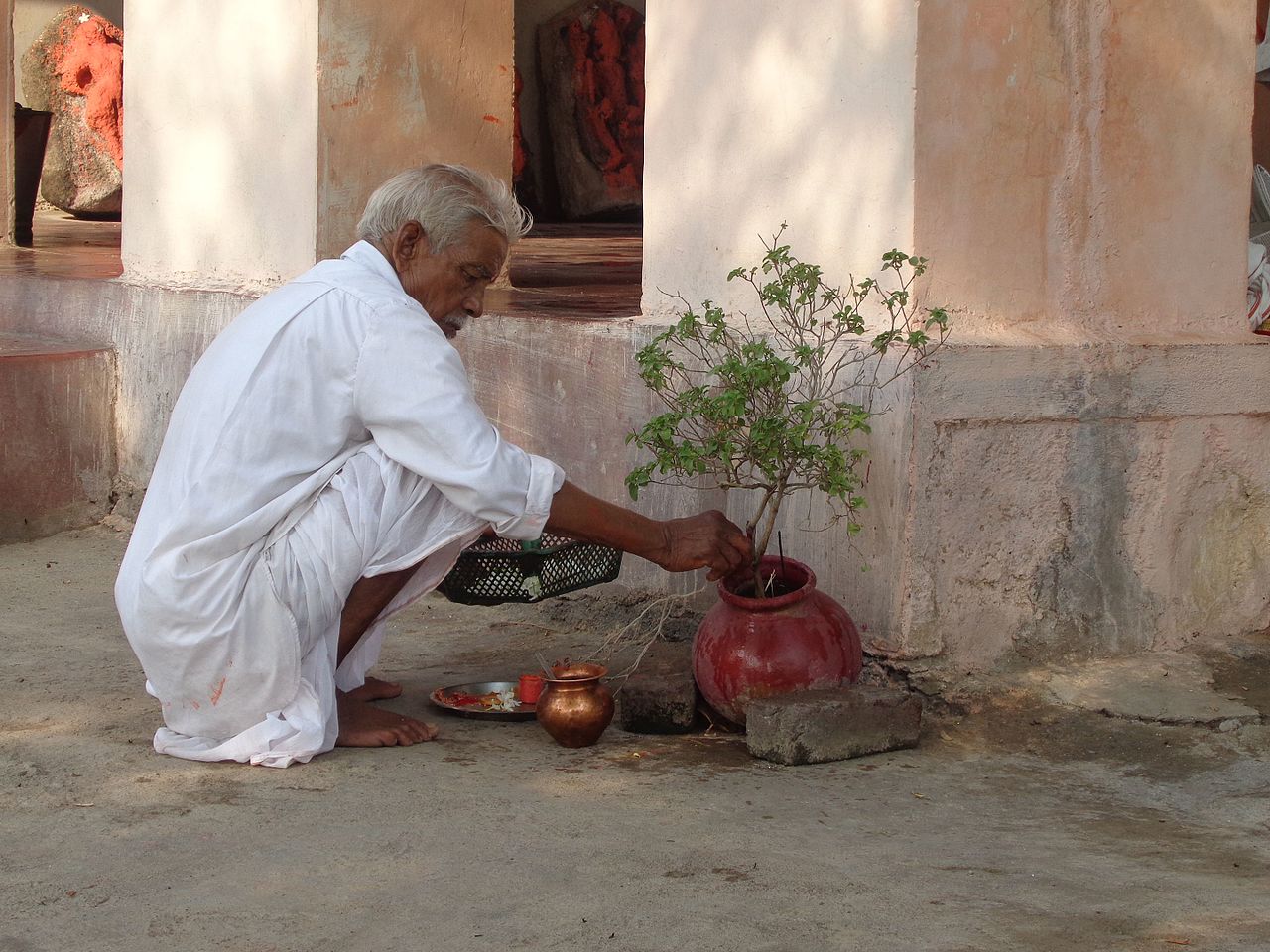 Although named by the Greeks, basil originated in India 5,000 years ago. In India today, the herb is considered a sacred herb. Holy basil, Ocimum tenuiflorum (also known as tulsi), is considered to be the manifestation of the goddess Tulasi, wife of Krishna. It is thought to have great spiritual and healing powers. According to legend, only one leaf of tulsi can outweigh Vishnu’s power. Every devout Hindu home will have a special place for a tulsi plant. It is believed that the creator god, Brahma, resides in its stems and branches, the river Ganges flows through the plant’s roots, the deities live in its leaves, and the most sacred of Hindu religious texts are in the top of holy basil’s branches (Simoons, 1998). Nurturing a tulsi plant ensures that a person’s sins will be forgiven and everlasting peace and joy will be had. (Simoons, 1998). The dried stems of old holy basil plants are used to make beads for Hindu meditation beads. Twentieth-century herbalist Maude Grieve said, “Every good Hindu goes to his rest with a basil leaf on his breast. This is his passport to heaven. It is indeed considered a powerful herb” (Grieve, 1931).
Although named by the Greeks, basil originated in India 5,000 years ago. In India today, the herb is considered a sacred herb. Holy basil, Ocimum tenuiflorum (also known as tulsi), is considered to be the manifestation of the goddess Tulasi, wife of Krishna. It is thought to have great spiritual and healing powers. According to legend, only one leaf of tulsi can outweigh Vishnu’s power. Every devout Hindu home will have a special place for a tulsi plant. It is believed that the creator god, Brahma, resides in its stems and branches, the river Ganges flows through the plant’s roots, the deities live in its leaves, and the most sacred of Hindu religious texts are in the top of holy basil’s branches (Simoons, 1998). Nurturing a tulsi plant ensures that a person’s sins will be forgiven and everlasting peace and joy will be had. (Simoons, 1998). The dried stems of old holy basil plants are used to make beads for Hindu meditation beads. Twentieth-century herbalist Maude Grieve said, “Every good Hindu goes to his rest with a basil leaf on his breast. This is his passport to heaven. It is indeed considered a powerful herb” (Grieve, 1931).
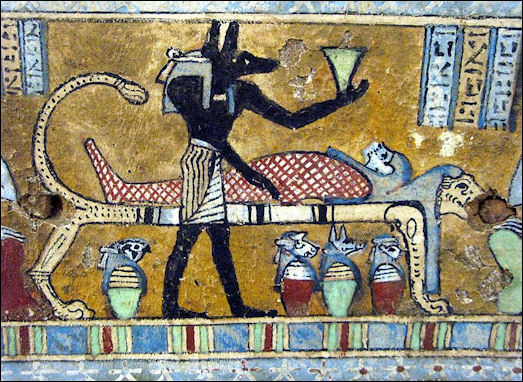 From India, basil spread to Egypt, where the herb was used for embalming and has been found buried with the pharaohs. The herb then moved on to Rome and southern Europe, where the Romans fell in love with it. In Italy, basil was considered a sign of love. If young girls were seeking a suitor, they would place a pot of basil on their windowsill. If a potential suitor showed up with a sprig of basil, the girl would love him forever.
From India, basil spread to Egypt, where the herb was used for embalming and has been found buried with the pharaohs. The herb then moved on to Rome and southern Europe, where the Romans fell in love with it. In Italy, basil was considered a sign of love. If young girls were seeking a suitor, they would place a pot of basil on their windowsill. If a potential suitor showed up with a sprig of basil, the girl would love him forever.
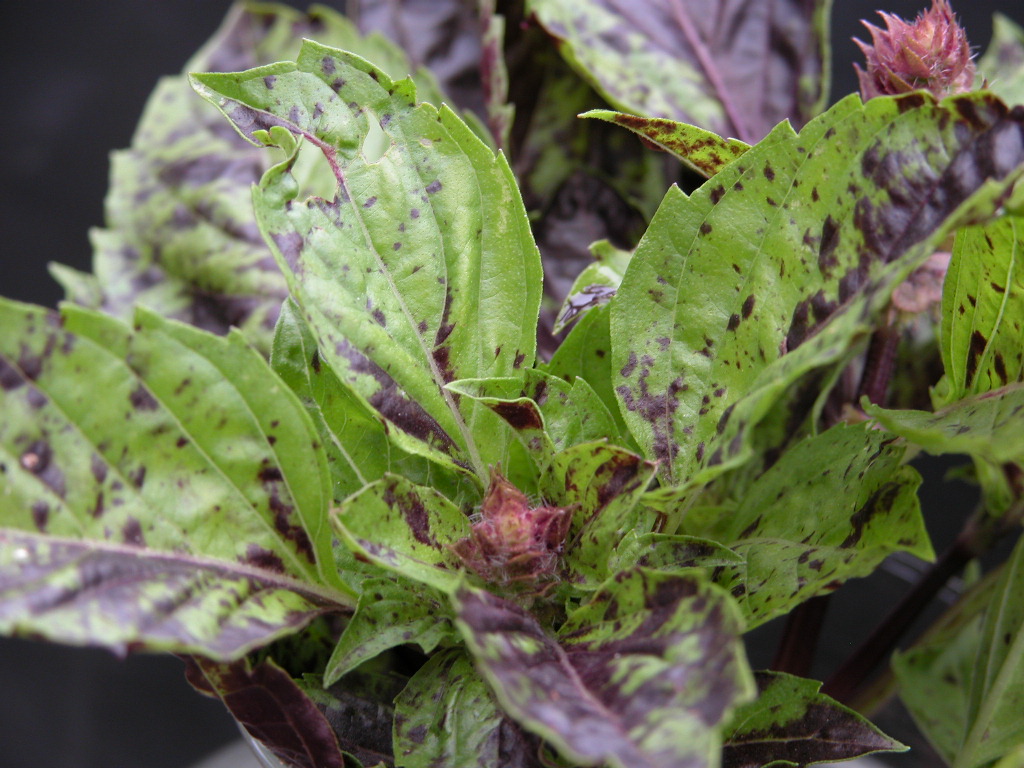 Italy became the home of pesto, which basil has made famous. “Pesto was created by the people of Genoa to highlight the flavor of their famous basil. Using a mortar and pestle, they combined simple ingredients to make one of the world’s most famous pasta sauces” (Blackman, 2010). The simple sauce contains only basil, pine nuts, olive oil, garlic, and parmigiano-reggiano cheese. Pesto is still a very popular sauce for pasta or crackers, especially in the summer, when fresh basil is plentiful.
Italy became the home of pesto, which basil has made famous. “Pesto was created by the people of Genoa to highlight the flavor of their famous basil. Using a mortar and pestle, they combined simple ingredients to make one of the world’s most famous pasta sauces” (Blackman, 2010). The simple sauce contains only basil, pine nuts, olive oil, garlic, and parmigiano-reggiano cheese. Pesto is still a very popular sauce for pasta or crackers, especially in the summer, when fresh basil is plentiful.
During the Middle Ages, they believed that in order to get basil to grow, one had to curse and scream while planting the seed. This is the origin of the French verb semer le basilic (sowing basil), which means “to rant.” It was also thought that if you smelled basil too much, scorpions would enter your brain. Today, the French call basil l’herbe royale, “the royal herb,” and pots of it are found in outdoor restaurants, not to deter scorpions but to deter mosquitoes. Fresh basil leaves are used to make pistou, the French version of pesto.
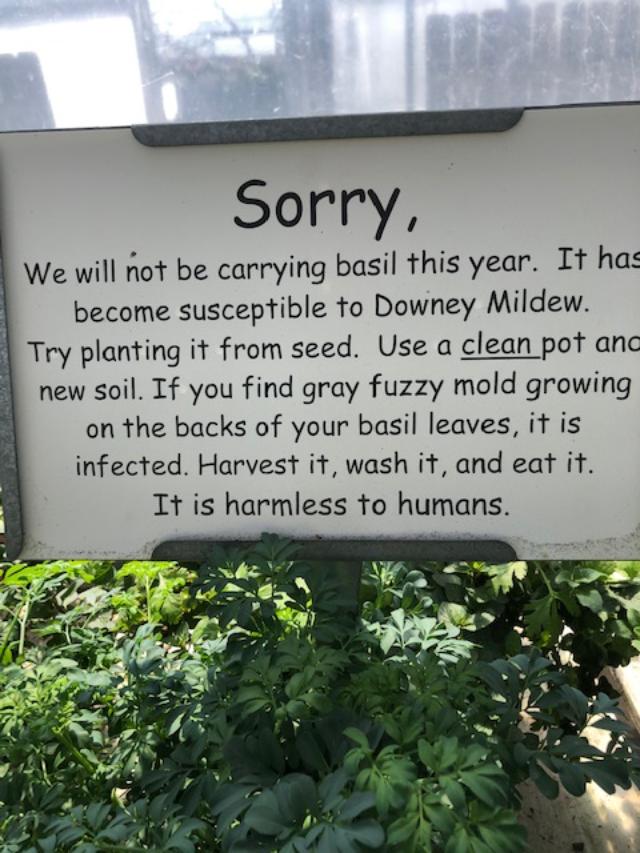 Basil, a sun-loving member of the mint family, is an annual herb that thrives in summer heat. In fact, it will languish if planted in the garden before temperatures reach a consistent 70 plus degrees. Frequent harvesting of the leaves before flowers appear prolongs its growing season. It can be propagated by seed or cuttings. However, it is very susceptible to downy mildew, which researchers are constantly trying to overcome by breeding more disease-resistant varieties. The new gene editing CRISPR technology may show a promising solution to this problem (Riccio, 2022).
Basil, a sun-loving member of the mint family, is an annual herb that thrives in summer heat. In fact, it will languish if planted in the garden before temperatures reach a consistent 70 plus degrees. Frequent harvesting of the leaves before flowers appear prolongs its growing season. It can be propagated by seed or cuttings. However, it is very susceptible to downy mildew, which researchers are constantly trying to overcome by breeding more disease-resistant varieties. The new gene editing CRISPR technology may show a promising solution to this problem (Riccio, 2022).
There are more than 100 varieties of basil and counting! Some basils are grown as ornamental plants because of their beautiful blooms. In fact, the Chinese name for basil translates to “nine-level pagoda,” which is a good description of its blooming stalk. African blue basil and wild magic basil are two examples of basils with nice blooms that I have found are bee magnets during the summer. If you are interested in attracting pollinators, your garden should certainly have these basils. Cardinal basil, which shows off its large burgundy flower clusters in late summer, is spectacular in the summer garden. It can also be used as a culinary basil. Lemon basil and ‘Mrs. Burns’ lemon basil, both having a lemon scent, are perfect for adding to lemonade, fruit salad, or ice cream. Add cinnamon basil to cinnamon flavored desserts. The showy leaves of purple ruffles basil, O. basilicum ‘Purple Ruffles’, make a nice contrast among other plants in the summer garden. When cooking with basil, it should be added at the end of cooking.
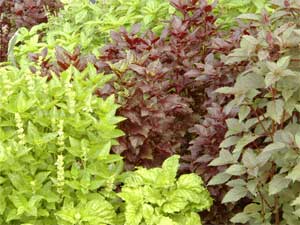 Basil is not usually considered a medicinal herb, but it was used medicinally in the time of Hippocrates who prescribed it as a tonic for the heart and to treat vomiting and constipation. Pliny the Elder commented that it was good for lethargy and fainting spells, headaches, flatulence, and other digestive issues (Pliny, 1855). China and India have a long history of using basil as a medicinal herb as well.
Basil is not usually considered a medicinal herb, but it was used medicinally in the time of Hippocrates who prescribed it as a tonic for the heart and to treat vomiting and constipation. Pliny the Elder commented that it was good for lethargy and fainting spells, headaches, flatulence, and other digestive issues (Pliny, 1855). China and India have a long history of using basil as a medicinal herb as well.
Basil does contain a healthy amount of vitamins A, C, and K and has antioxidant and antibacterial properties, which helps fight disease. Studies show that it can help reduce blood clots by making the blood less “sticky.” Animal studies suggest that it might help slow the growth rate of some types of cancer (Todd, 2015).
 So, do enjoy fresh basil this summer. Remember to dry some for the winter, freeze the leaves, or combine chopped leaves with water and freeze in an ice cube tray for later use. However, you should take careful consideration before putting basil on your windowsill lest you attract an unwanted suitor.
So, do enjoy fresh basil this summer. Remember to dry some for the winter, freeze the leaves, or combine chopped leaves with water and freeze in an ice cube tray for later use. However, you should take careful consideration before putting basil on your windowsill lest you attract an unwanted suitor.
Basil is The Herb Society’s Herb of the Month for June.
References
Blackman, Vicki. 2010. Basil it’s not just for Italian food anymore. Texas Gardener. Vol. 29, Issue 2, p. 20-25.
Lum, Linda. (2020). Exploring basil: a simple plant with a complicated history. Accessed 5/16/22. https://delishably.com/spices-seasonings/All-About-Herbs-Basil
Matel, Kathy. 2016. History of basil. Accessed 5/15/22. https://catrinasgarden.com/history-basil/
MyParea. (n.d.) Basil in Greek culture. Accessed 5/15/22. https://blog.myparea.com/basil-greekculture/#:~:text=For%20ancient%20Greeks%2C%20basil%20was,used%20to%20sprinkle%20holy%20water
Pliny the Elder. 1855. The natural history. John Bostock, M.D. (ed.). London: Taylor and Francis, Red Lion Court, Fleet Street. 1855. Accessed 5/15/22. http://www.perseus.tufts.edu/hopper/text?doc=Perseus:text:1999.02.0137:book=20:chapter=48&highlight=ocimum
Riccio, Peggy. 2022. Breeding better herbs. The American Gardener. Vol. 101, No. 2, p. 30-34.
Simoons, Frederick. 1998. Plants of life, plants of death. Madison, WI: University of Wisconsin Press.
Todd, Kathy. 2015. Basil: King of herbs. Environmental Nutrition. Vol 38, Issue 7, p.8.
Yancy-Keller, Alexandra. 2020. History of basil. Accessed 5/15/22. https://www.nutrifitonline.com/blog/news/history-of-basil/
Medicinal Disclaimer: It is the policy of The Herb Society of America, Inc. not to advise or recommend herbs for medicinal or health use. This information is intended for educational purposes only and should not be considered as a recommendation or an endorsement of any particular medical or health treatment. Please consult a health care provider before pursuing any herbal treatments.
Photo Credits: 1) Basil leaves (Ocimum basilicum) (Maryann Readal); 2) Man worshipping tulsi basil (Wikimedia Commons, Shirsh.namaward); 3) Egyptian embalming (Catrina’s Garden, https://catrinasgarden.com/history-basil/); 4) Variegated basil leaves (Ocimum cv.) (Chrissy Moore); 5) Sign at garden center regarding basil and downy mildew (Maryann Readal); 6) Varieties of basil (US National Arboretum); 7) Plate of brownies made with cinnamon basil (Chrissy Moore).
Maryann is the Secretary of The Herb Society of America and a Texas Master Gardener. She is a member of The Society’s Texas Thyme Unit in Huntsville, TX. She lectures on herbs and does the herb training for several Master Gardener programs. She gardens among the pines in the Piney Woods of East Texas.


 Before going to Costa Rica, I researched gardens, restaurants, herbs, spices, botanicals and the rainforest—places where I wanted to go, see, and experience. Once I visited Villa Vanilla’s website,
Before going to Costa Rica, I researched gardens, restaurants, herbs, spices, botanicals and the rainforest—places where I wanted to go, see, and experience. Once I visited Villa Vanilla’s website,  plants. The tour begins and ends at the post-harvest warehouse, where my eyes feasted on the spectacle of the ground covered with burlap sacks, which were spread with vanilla beans in various stages of fermentation and curing, and my nose filled with the delightfully overwhelming perfume of vanilla.
plants. The tour begins and ends at the post-harvest warehouse, where my eyes feasted on the spectacle of the ground covered with burlap sacks, which were spread with vanilla beans in various stages of fermentation and curing, and my nose filled with the delightfully overwhelming perfume of vanilla. cookie speckled with cacao nibs. And the grand finale was a scoop of homemade vanilla bean ice cream made with farm fresh milk and cream from the farm’s own dairy cow.
cookie speckled with cacao nibs. And the grand finale was a scoop of homemade vanilla bean ice cream made with farm fresh milk and cream from the farm’s own dairy cow.  the stem. Green pods are placed in a large, clear plastic bag, which begins the fermentation process. Then they are laid outdoors in the sun every morning for four hours. Next, they are placed in insulated boxes while they are still warm from the sun and brought inside the warehouse for twenty hours. This is repeated every day for about three to four days. This process of sweating the beans in the sun makes a superior fermented end-product. (In other parts of the world, green beans are dropped in boiling water rather than curing in the sun.) After a week, the pods have turned brown, and they are removed from the plastic bags and spread out on burlap sacks. The four hours of sun/twenty hours in the dark process is continued for another three to four weeks until the pods have begun
the stem. Green pods are placed in a large, clear plastic bag, which begins the fermentation process. Then they are laid outdoors in the sun every morning for four hours. Next, they are placed in insulated boxes while they are still warm from the sun and brought inside the warehouse for twenty hours. This is repeated every day for about three to four days. This process of sweating the beans in the sun makes a superior fermented end-product. (In other parts of the world, green beans are dropped in boiling water rather than curing in the sun.) After a week, the pods have turned brown, and they are removed from the plastic bags and spread out on burlap sacks. The four hours of sun/twenty hours in the dark process is continued for another three to four weeks until the pods have begun  to shrivel and have lost about 80% of their original weight. Then they are left to cure—and this time varies among farmers—from nine months to two years. Villa Vanilla cures their beans for two years for best flavor and quality.
to shrivel and have lost about 80% of their original weight. Then they are left to cure—and this time varies among farmers—from nine months to two years. Villa Vanilla cures their beans for two years for best flavor and quality. The vanilla orchid’s flower is not showy; it has only a slight scent with no element of vanilla flavor or aroma. When its pale-yellow flowers are pollinated, the ovaries swell and develop into the fruits we call “pods” or “beans,” just like extra-long green beans. Pollination in the wild is very iffy, so most growers hand pollinate to ensure a viable crop. This is very labor intensive and has to be done when the flower is just open, which is a very brief window of time–literally a few hours on a single day. Each pod contains tens of thousands of tiny black seeds. The growing process lasts up to nine months, but only when the pods turn brown after being dried and cured do they develop the distinctive aroma we call “vanilla.” Drying, curing, and conditioning the pods is an art, which, if done properly, takes at least another nine months. Understandably, vanilla is one of the most labor-intensive agricultural products in the world.
The vanilla orchid’s flower is not showy; it has only a slight scent with no element of vanilla flavor or aroma. When its pale-yellow flowers are pollinated, the ovaries swell and develop into the fruits we call “pods” or “beans,” just like extra-long green beans. Pollination in the wild is very iffy, so most growers hand pollinate to ensure a viable crop. This is very labor intensive and has to be done when the flower is just open, which is a very brief window of time–literally a few hours on a single day. Each pod contains tens of thousands of tiny black seeds. The growing process lasts up to nine months, but only when the pods turn brown after being dried and cured do they develop the distinctive aroma we call “vanilla.” Drying, curing, and conditioning the pods is an art, which, if done properly, takes at least another nine months. Understandably, vanilla is one of the most labor-intensive agricultural products in the world.  There are more than a hundred different species of vanilla orchid, and they grow all over the tropics with the exception of Australia. All of the vanilla orchids produce fruits containing seeds, but only a few species bear the large aromatic pods that can be used commercially. Virtually all of the cultivated vanilla in the world today comes from just one species,
There are more than a hundred different species of vanilla orchid, and they grow all over the tropics with the exception of Australia. All of the vanilla orchids produce fruits containing seeds, but only a few species bear the large aromatic pods that can be used commercially. Virtually all of the cultivated vanilla in the world today comes from just one species, 
 Last week we looked at some of the beverages important to a Trinidad Christmas. Now let’s talk about some of the foods and the special ingredients needed to make them.
Last week we looked at some of the beverages important to a Trinidad Christmas. Now let’s talk about some of the foods and the special ingredients needed to make them. into a party and making large quantities assembly-line style. This is part of what makes them such a Christmas treat. Every island has their own version, and in Trinidad, it is traditionally cornmeal stuffed with beef, chicken, or pork (or a mixture) with olives, capers, and raisins and steamed in banana leaves. There are also versions made with fish or shrimp, and vegetarian versions made with soy products, lentils, or mushrooms. It is the flavorings that really make them special, and the usual additions include onion, garlic, tomato paste or ketchup, Worcestershire sauce, Trinidad pimento peppers, and roucou.
into a party and making large quantities assembly-line style. This is part of what makes them such a Christmas treat. Every island has their own version, and in Trinidad, it is traditionally cornmeal stuffed with beef, chicken, or pork (or a mixture) with olives, capers, and raisins and steamed in banana leaves. There are also versions made with fish or shrimp, and vegetarian versions made with soy products, lentils, or mushrooms. It is the flavorings that really make them special, and the usual additions include onion, garlic, tomato paste or ketchup, Worcestershire sauce, Trinidad pimento peppers, and roucou. mild Capsicum chinense (the species known for blazing hot peppers like habaneros) and are easily found in most Caribbean markets here in the U.S., as well as most backyards in Trinidad, according to Ann. The taste is described as the flavor of very hot peppers without any of the heat, and they are an essential ingredient in many dishes. This pepper seems relatively unknown outside of Caribbean circles, but you may find seeds marketed as Capsicum ‘Trinidad Pimento’ or ‘Trinidad Seasoning Pepper.’
mild Capsicum chinense (the species known for blazing hot peppers like habaneros) and are easily found in most Caribbean markets here in the U.S., as well as most backyards in Trinidad, according to Ann. The taste is described as the flavor of very hot peppers without any of the heat, and they are an essential ingredient in many dishes. This pepper seems relatively unknown outside of Caribbean circles, but you may find seeds marketed as Capsicum ‘Trinidad Pimento’ or ‘Trinidad Seasoning Pepper.’  color comes from the waxy coating that covers the seeds. In Trinidad, it is common to grow roucou in your yard. The spiky capsules are harvested when ripe, split open, and the seeds are removed. The seeds are placed in water, then soaked and agitated (wear gloves!) to release the coloring. The now vibrant red/orange liquid has salt added as a preservative, the seeds are strained out, and the liquid is refrigerated to use as needed. It is a common ingredient in many dishes in Trinidad and adds not only a beautiful color but a subtle unique flavor as well. Annatto powder may be substituted and is easily purchased online and at International markets.
color comes from the waxy coating that covers the seeds. In Trinidad, it is common to grow roucou in your yard. The spiky capsules are harvested when ripe, split open, and the seeds are removed. The seeds are placed in water, then soaked and agitated (wear gloves!) to release the coloring. The now vibrant red/orange liquid has salt added as a preservative, the seeds are strained out, and the liquid is refrigerated to use as needed. It is a common ingredient in many dishes in Trinidad and adds not only a beautiful color but a subtle unique flavor as well. Annatto powder may be substituted and is easily purchased online and at International markets. Chadon beni (pronounced “shadow benny”) is the common name for the leaves of Eryngium foetidum, a tropical perennial in the carrot family (Apiaceae) and known in the United States as culantro. Imported by French settlers, the name derives from “chardon béni,” which means “blessed thistle.” (It is not actually a thistle but looks a bit like one.) According to Ann, it grows like a weed everywhere in Trinidad and is easy to cultivate. The flavor is similar to cilantro but even stronger and more pungent. It is one of several herbs that are an essential component of the flavor of Trinidadian cuisine. The fresh leaves can usually be found in Caribbean markets.
Chadon beni (pronounced “shadow benny”) is the common name for the leaves of Eryngium foetidum, a tropical perennial in the carrot family (Apiaceae) and known in the United States as culantro. Imported by French settlers, the name derives from “chardon béni,” which means “blessed thistle.” (It is not actually a thistle but looks a bit like one.) According to Ann, it grows like a weed everywhere in Trinidad and is easy to cultivate. The flavor is similar to cilantro but even stronger and more pungent. It is one of several herbs that are an essential component of the flavor of Trinidadian cuisine. The fresh leaves can usually be found in Caribbean markets. thyme, Indian borage, Cuban oregano, and many more. It is naturalized and cultivated widely in the tropics and as an herb. It has a strong oregano-like flavor.
thyme, Indian borage, Cuban oregano, and many more. It is naturalized and cultivated widely in the tropics and as an herb. It has a strong oregano-like flavor. Christmas, you prepare the fruits and cover them in a jar with a blend of alcohols and leave it in a dark place for a year, shaking periodically. Spices are also essential to making the quintessential black cake, which typically include cinnamon, allspice, nutmeg, clove, and tonka bean.
Christmas, you prepare the fruits and cover them in a jar with a blend of alcohols and leave it in a dark place for a year, shaking periodically. Spices are also essential to making the quintessential black cake, which typically include cinnamon, allspice, nutmeg, clove, and tonka bean.  Because it contains coumarin, a chemical that is toxic in larger amounts, tonka bean has been banned as a food ingredient in the U.S. since 1953. It is now better understood that the concentration of coumarin in tonka bean is too low to cause illness without one consuming a nearly impossible quantity. However, the ban remains.
Because it contains coumarin, a chemical that is toxic in larger amounts, tonka bean has been banned as a food ingredient in the U.S. since 1953. It is now better understood that the concentration of coumarin in tonka bean is too low to cause illness without one consuming a nearly impossible quantity. However, the ban remains.  Recipes
Recipes It turned out that “sorrel” is a name for the calyces of Hibiscus sabdariffa, a plant commonly known as roselle, as well as the beverage that is made from them. If you have ever tasted Celestial Seasonings Red Zinger tea, then you have tasted sorrel. (This sorrel is not related to the leaves of
It turned out that “sorrel” is a name for the calyces of Hibiscus sabdariffa, a plant commonly known as roselle, as well as the beverage that is made from them. If you have ever tasted Celestial Seasonings Red Zinger tea, then you have tasted sorrel. (This sorrel is not related to the leaves of  Another essential Trinidadian Christmas drink is one more familiar to most Americans. Ponche de crème is their flavorful take on eggnog. Served straight or spiked with rum, this delicious drink must contain a special Trinidad ingredient: Angostura Bitters. You may be familiar with
Another essential Trinidadian Christmas drink is one more familiar to most Americans. Ponche de crème is their flavorful take on eggnog. Served straight or spiked with rum, this delicious drink must contain a special Trinidad ingredient: Angostura Bitters. You may be familiar with  Lastly, the third beverage essential to Christmas in Trinidad is also enjoyed year-round: ginger beer. Ginger beer is a strongly flavored version of ginger ale that is non-alcoholic. The rhizome of Zingiber officinalis contains volatile oils, such as zingerone and gingerols, that give ginger its characteristic “zing.” Most families in Trinidad, as well as the rest of the Caribbean, make their ginger beer at home from fresh ginger rhizomes, and the resulting ginger beer often has a very strong punch of ginger flavor. It contains other spices such as cinnamon and clove. It is made very strong, and it can be diluted with water or club soda to suit your taste.
Lastly, the third beverage essential to Christmas in Trinidad is also enjoyed year-round: ginger beer. Ginger beer is a strongly flavored version of ginger ale that is non-alcoholic. The rhizome of Zingiber officinalis contains volatile oils, such as zingerone and gingerols, that give ginger its characteristic “zing.” Most families in Trinidad, as well as the rest of the Caribbean, make their ginger beer at home from fresh ginger rhizomes, and the resulting ginger beer often has a very strong punch of ginger flavor. It contains other spices such as cinnamon and clove. It is made very strong, and it can be diluted with water or club soda to suit your taste. 1 package dried sorrel (Angel brand easily available online or in Caribbean market)
1 package dried sorrel (Angel brand easily available online or in Caribbean market) The two most common cinnamon species are “true” or Ceylon cinnamon (
The two most common cinnamon species are “true” or Ceylon cinnamon ( Cinnamon was first traded by the Arabs who protected their source of the spice by telling fantastic tales of how wild birds guarded the cinnamon trees. References to cinnamon were found in ancient Chinese botanical medical texts dating back to 2800 BCE. Cinnamon has been used in Ayurvedic medicine for thousands of years. The Egyptians used cinnamon in the embalming process, as a medicine, and as a flavoring for beverages. There are a number of references to cinnamon in the Bible as an ingredient in Moses’ anointing oils (Exodus) and as a token of friendship between lovers and friends (Proverbs), while the Romans burned cinnamon on their funeral pyres. In 65 CE, Nero burned a year’s supply of cinnamon during his second wife’s funeral ─ a wife who he had assassinated.
Cinnamon was first traded by the Arabs who protected their source of the spice by telling fantastic tales of how wild birds guarded the cinnamon trees. References to cinnamon were found in ancient Chinese botanical medical texts dating back to 2800 BCE. Cinnamon has been used in Ayurvedic medicine for thousands of years. The Egyptians used cinnamon in the embalming process, as a medicine, and as a flavoring for beverages. There are a number of references to cinnamon in the Bible as an ingredient in Moses’ anointing oils (Exodus) and as a token of friendship between lovers and friends (Proverbs), while the Romans burned cinnamon on their funeral pyres. In 65 CE, Nero burned a year’s supply of cinnamon during his second wife’s funeral ─ a wife who he had assassinated.  So where are we today with cinnamon, besides it being a necessary ingredient in our cinnamon buns, cinnamon candies, and apple pie? Several clinical studies have shown that cinnamon does help control fasting blood glucose levels in Type 2 diabetes and pre-diabetic individuals. It has also been found to lower LDL cholesterol and triglycerides. However, the National Institute of Health feels not enough study has been done to make a definitive recommendation for using cinnamon as a treatment. They do recommend that, if using cinnamon as a food supplement or medicine, the lower coumarin Ceylon cinnamon should be used.
So where are we today with cinnamon, besides it being a necessary ingredient in our cinnamon buns, cinnamon candies, and apple pie? Several clinical studies have shown that cinnamon does help control fasting blood glucose levels in Type 2 diabetes and pre-diabetic individuals. It has also been found to lower LDL cholesterol and triglycerides. However, the National Institute of Health feels not enough study has been done to make a definitive recommendation for using cinnamon as a treatment. They do recommend that, if using cinnamon as a food supplement or medicine, the lower coumarin Ceylon cinnamon should be used.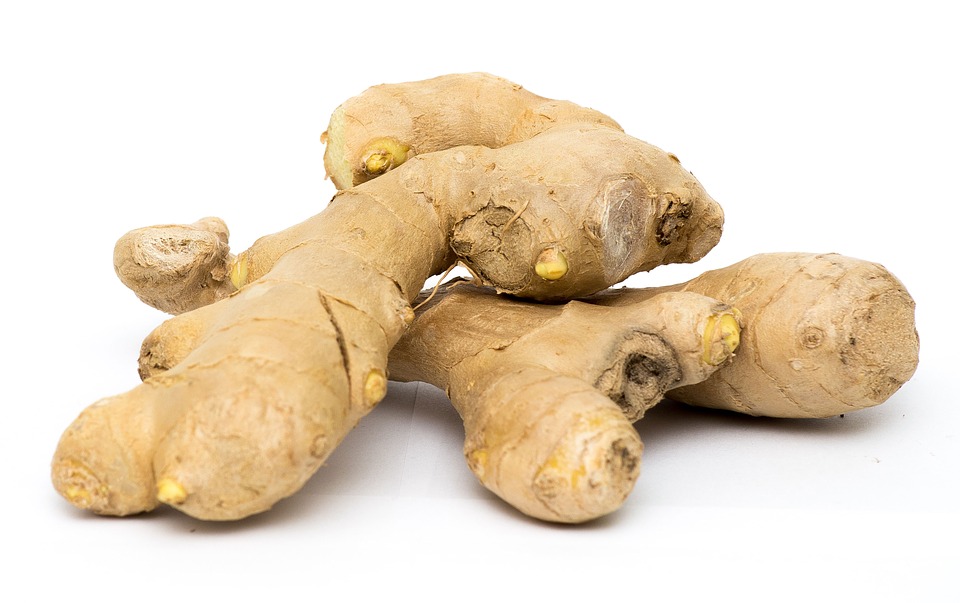 Ginger (fresh, thinly sliced)
Ginger (fresh, thinly sliced) Coffee (whole bean, crushed, or cold brewed)
Coffee (whole bean, crushed, or cold brewed) Chocolate (cocoa nibs)
Chocolate (cocoa nibs)
 Hibiscus (dried calyx)
Hibiscus (dried calyx) Cardamom, Clove, Nutmeg, or Cinnamon
Cardamom, Clove, Nutmeg, or Cinnamon
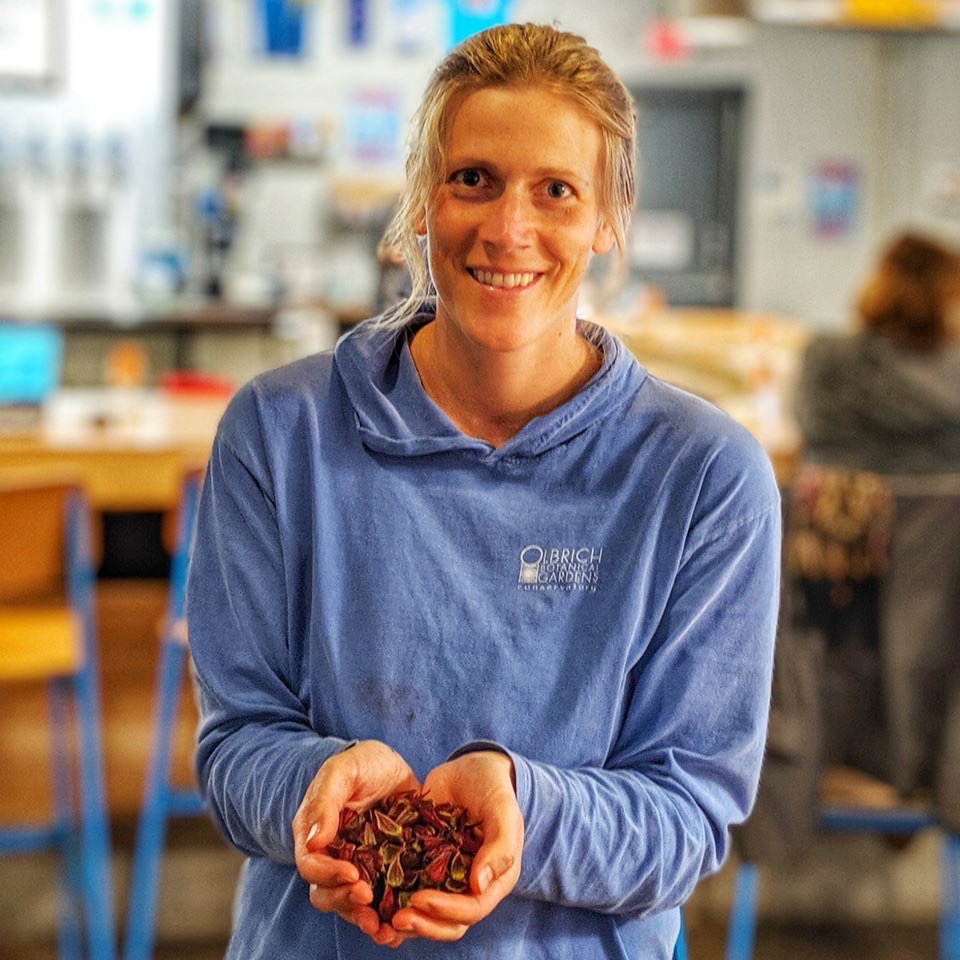 Amanda got her B.S. in Environmental Horticulture with an emphasis on floriculture crop production from the University of Minnesota, Twin Cities. She has always had a strong passion for anything involving the outdoors/nature and plants/animals. Her wide array of experience in the horticulture field at botanical gardens, arboreta, nurseries, and farms has led her to become the Assistant Conservatory Curator at Olbrich Botanical Gardens in Madison, WI. Amanda works in the tropical conservatory and oversees the production of the annuals that go out in Olbrich’s 16 acres of gardens. For the past 10 years, she has had a strong passion for craft beer and brewing, and hopes to one day become a Certified Cicerone.
Amanda got her B.S. in Environmental Horticulture with an emphasis on floriculture crop production from the University of Minnesota, Twin Cities. She has always had a strong passion for anything involving the outdoors/nature and plants/animals. Her wide array of experience in the horticulture field at botanical gardens, arboreta, nurseries, and farms has led her to become the Assistant Conservatory Curator at Olbrich Botanical Gardens in Madison, WI. Amanda works in the tropical conservatory and oversees the production of the annuals that go out in Olbrich’s 16 acres of gardens. For the past 10 years, she has had a strong passion for craft beer and brewing, and hopes to one day become a Certified Cicerone.